Do you have an account?
Log in, so that checkout is faster.
Availability for pickups could not be loaded
Item number: 400311
Delivery time: 2-3 working days
View full details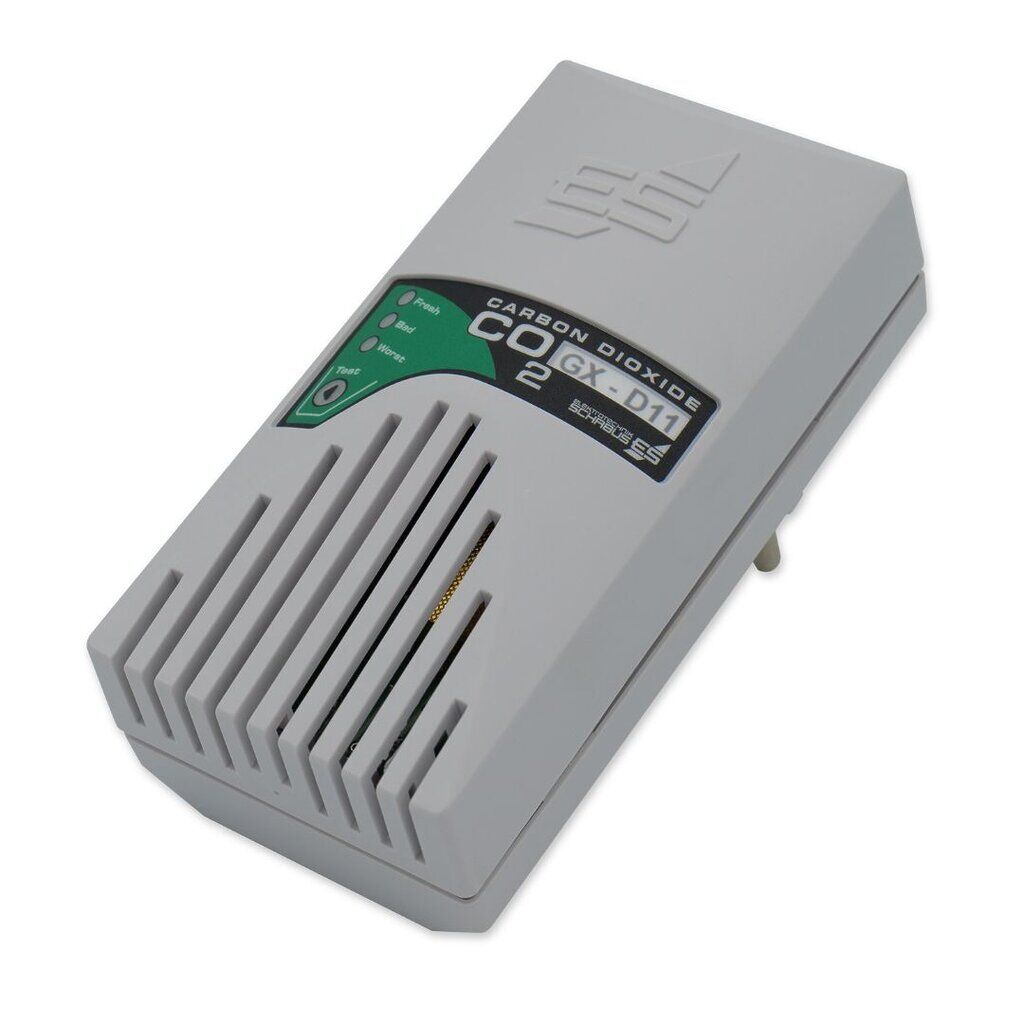

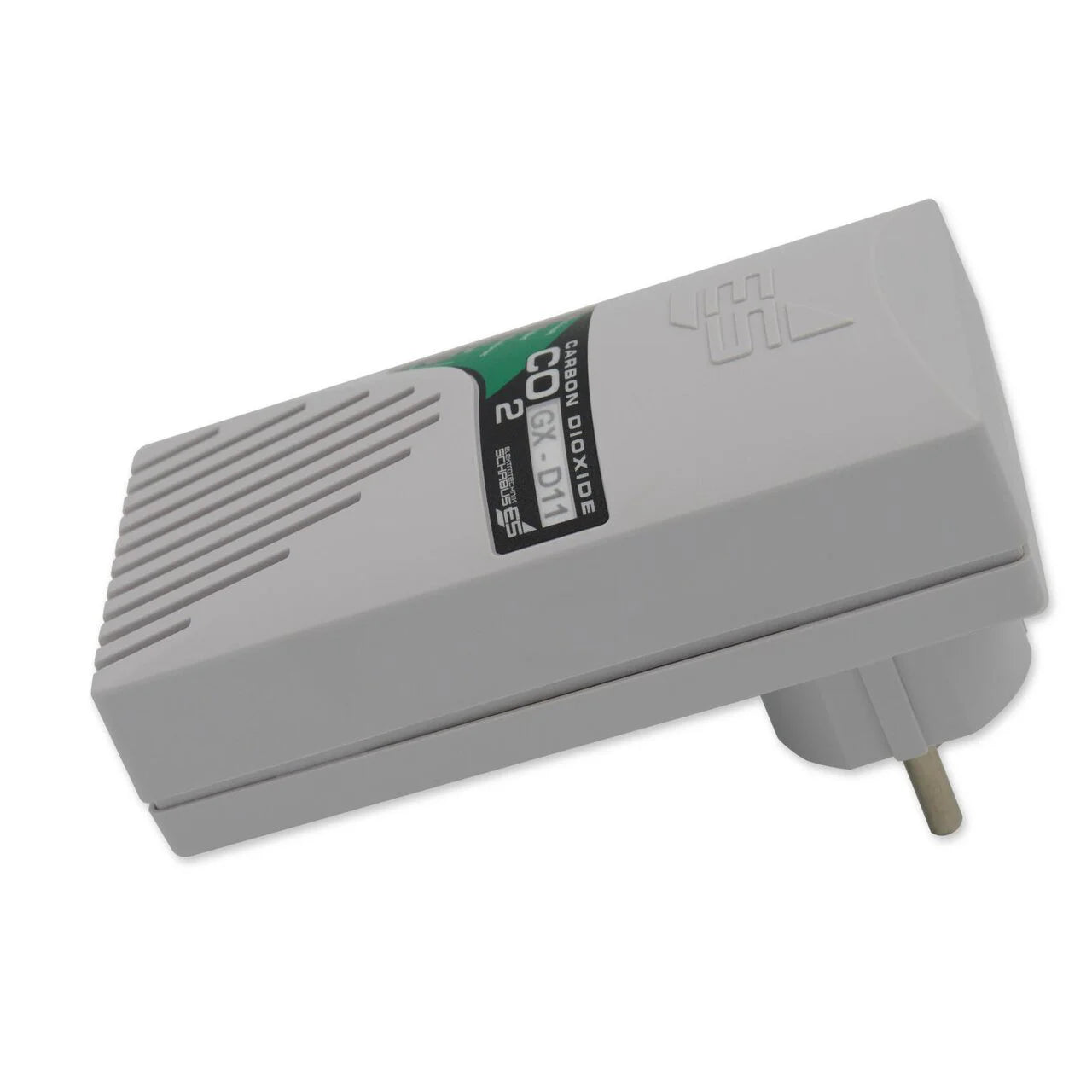
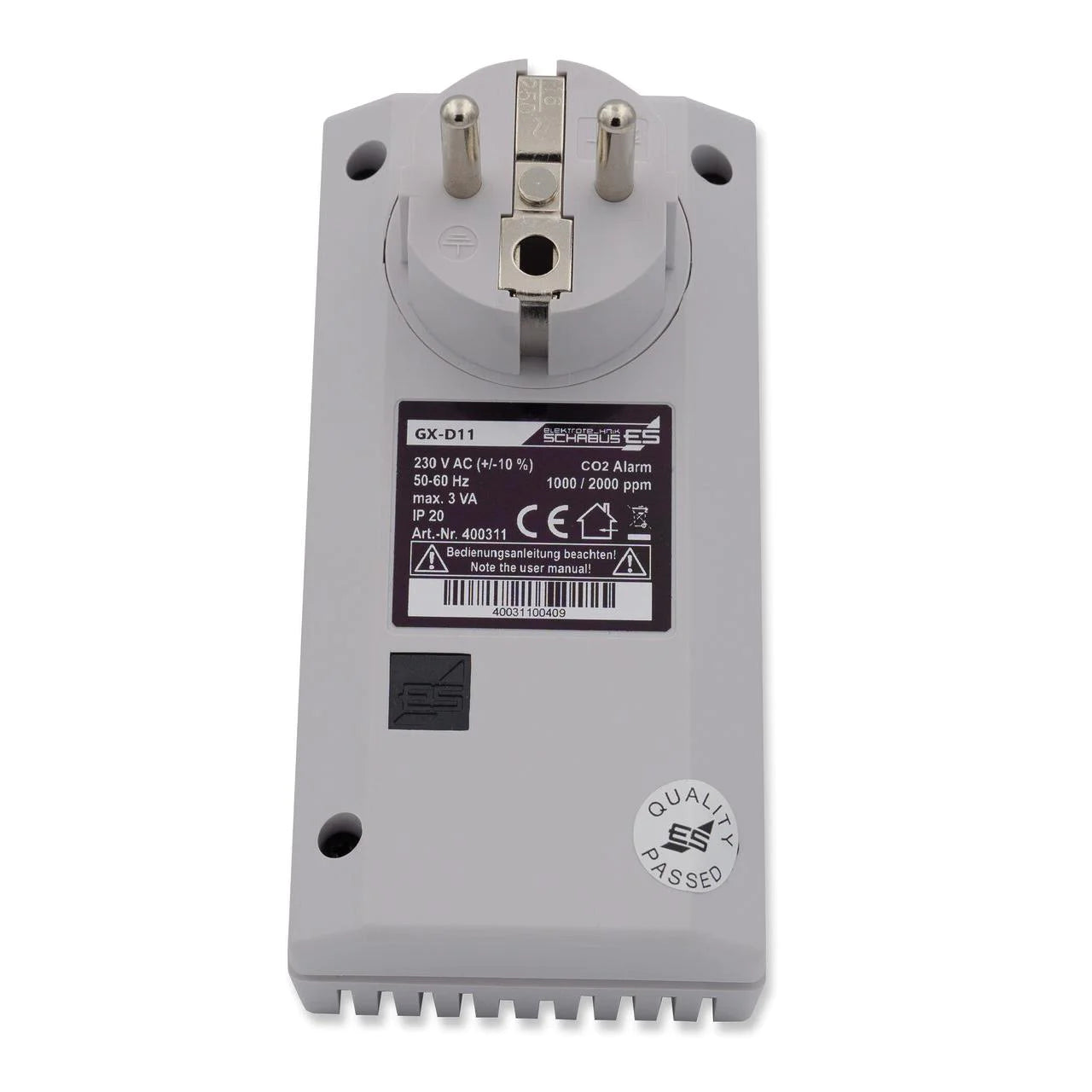
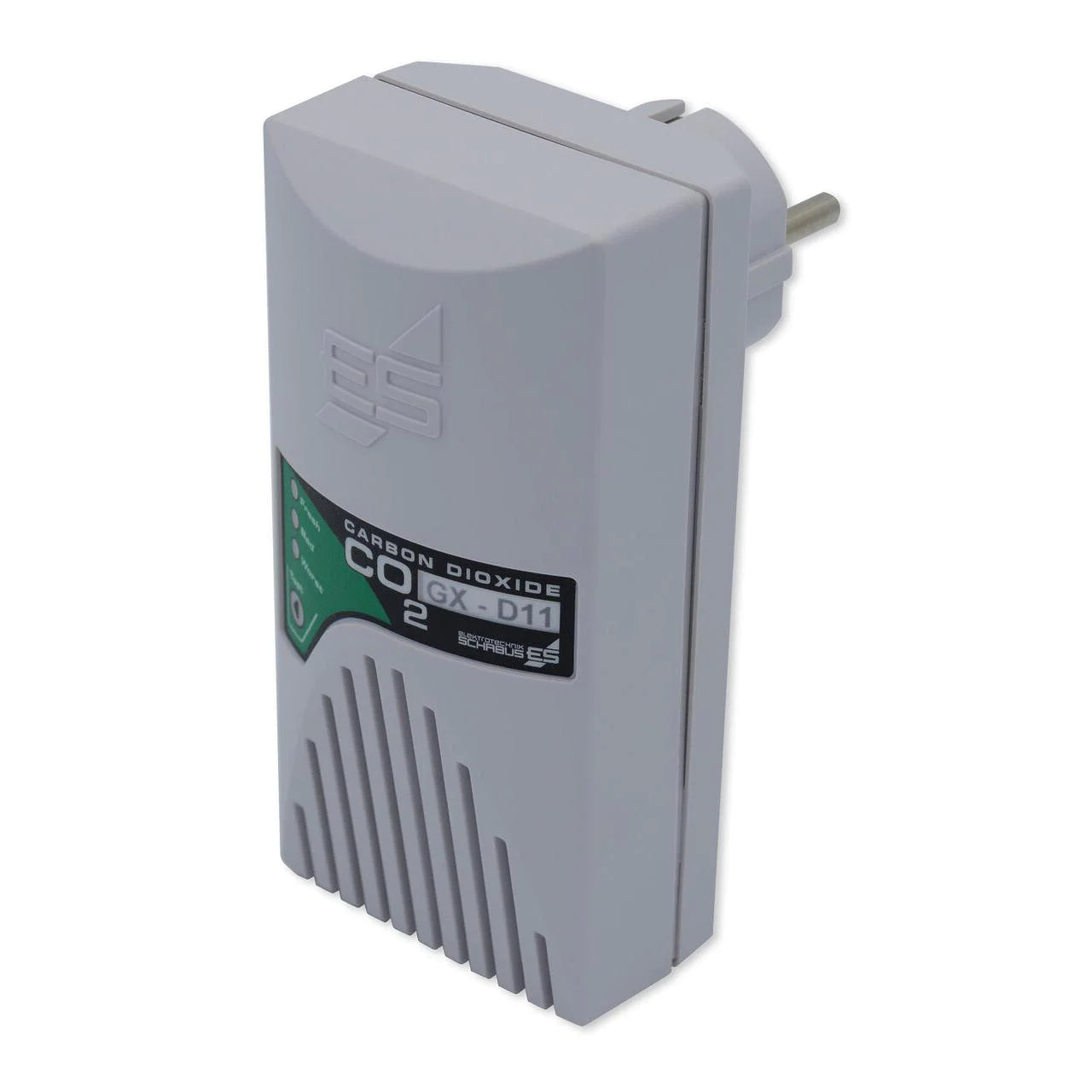
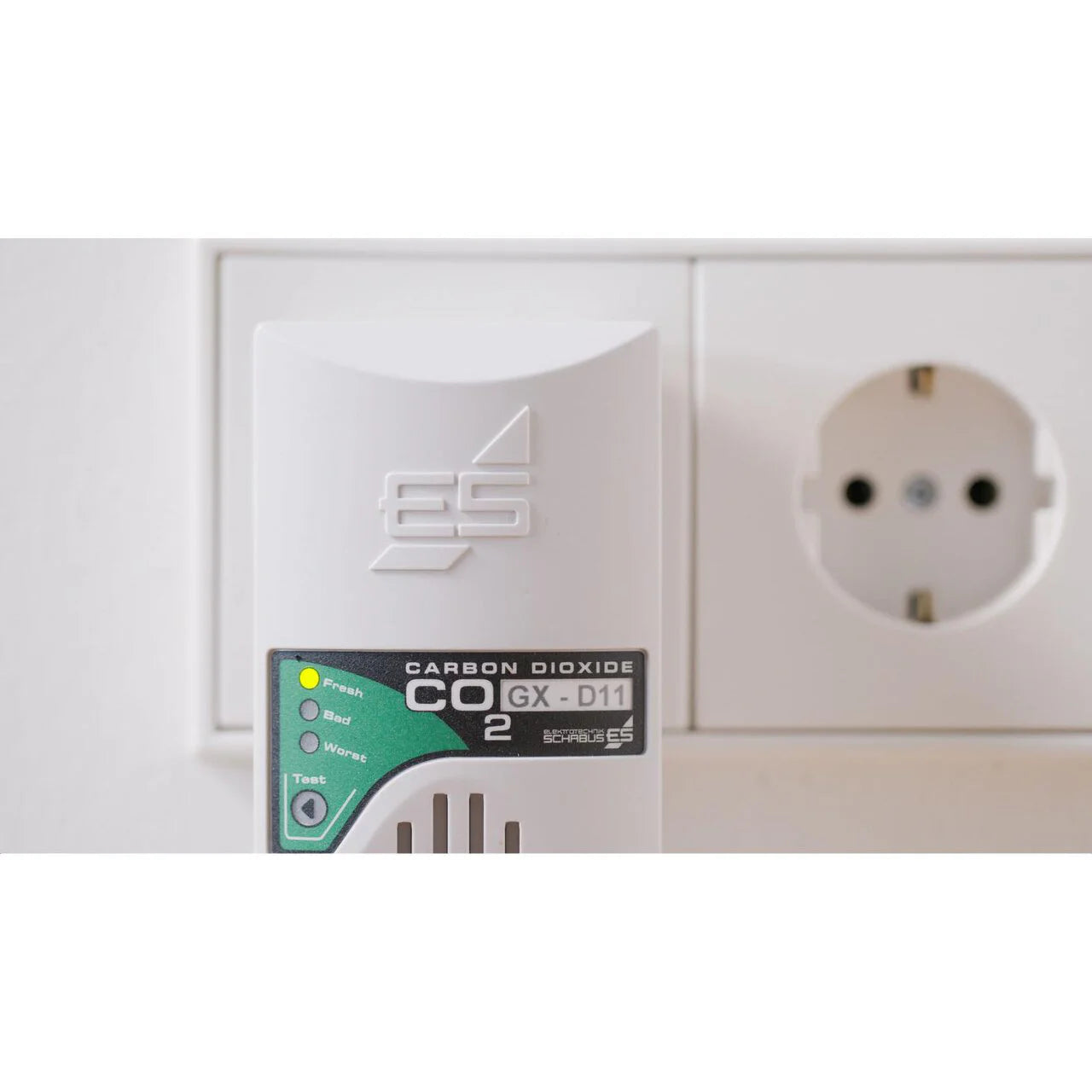
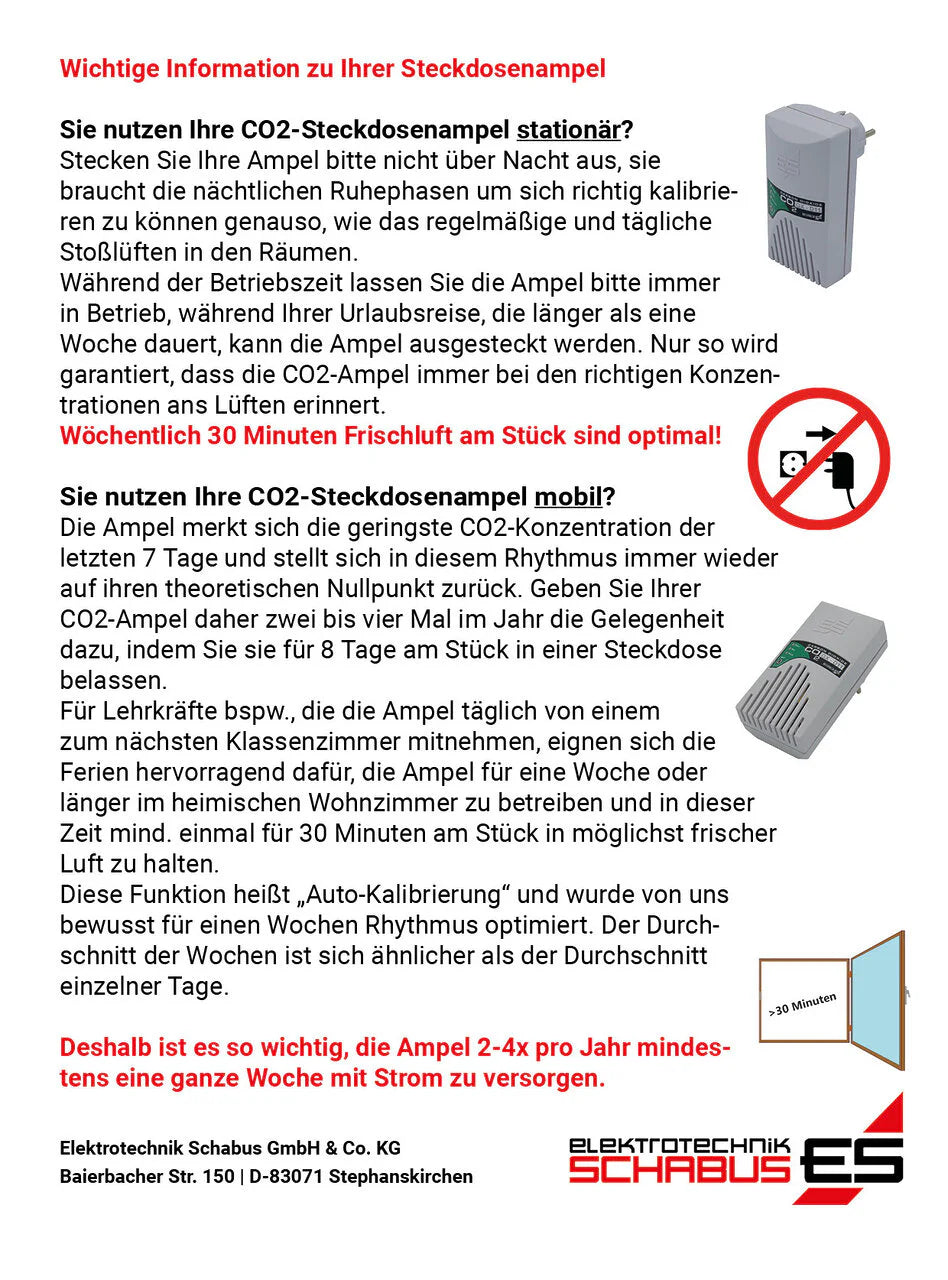
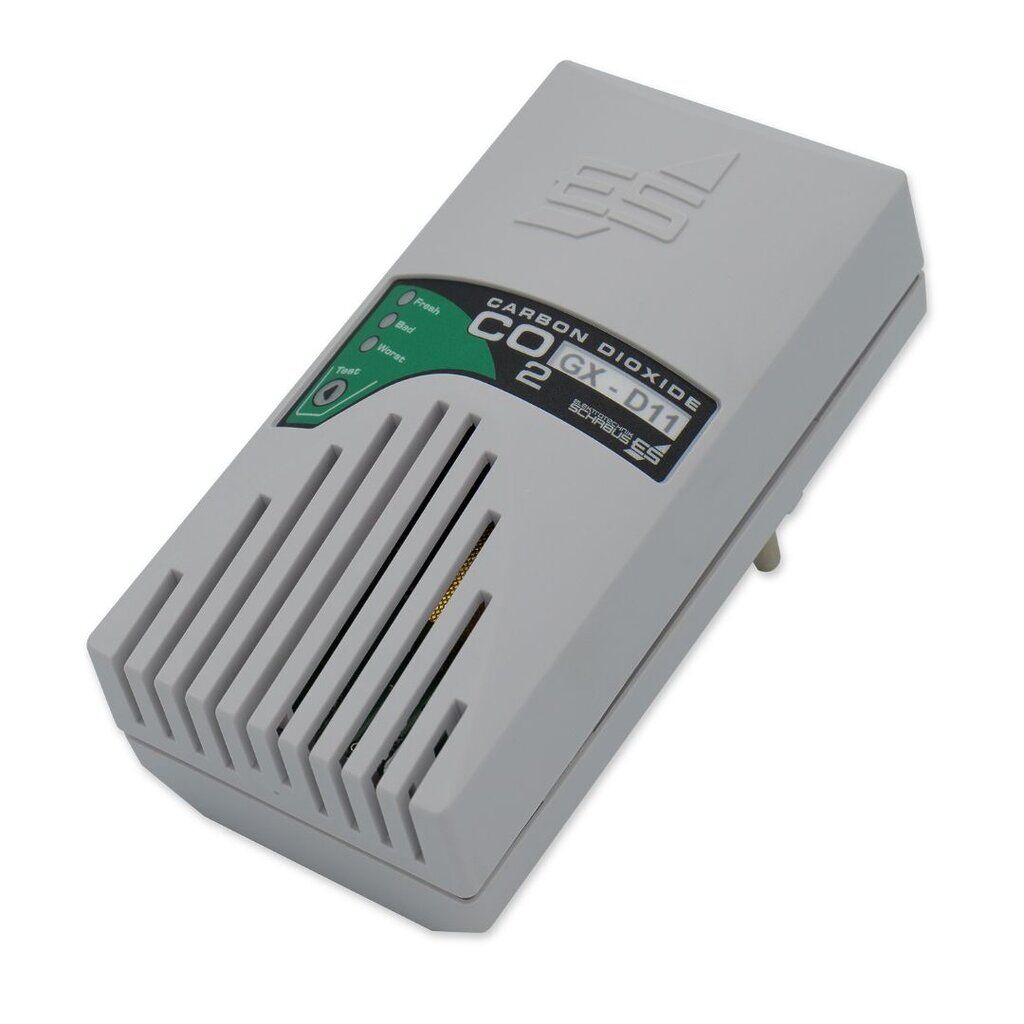
The GX-D11 CO₂ Traffic Light is a compact warning device for mobile use that simply plugs into a free electrical outlet. After a short warm-up phase of approximately three minutes, the device displays the current CO₂ concentration. The display is provided by a three-stage LED system (green, yellow, red) and is complemented by a subtle acoustic signal that can be muted if desired.
An integrated NDIR infrared sensor precisely measures the CO₂ concentration and is insensitive to air purification devices, as these cannot filter CO₂ from the air.
The threshold values are based on the recommendations of the Robert Koch Institute for school operations:
The GX-D11 reliably reminds you to ventilate regularly, thus helping to reduce indoor germ counts without causing rooms to cool down unnecessarily. This is particularly beneficial in areas such as waiting rooms or meeting rooms, as CO2 not only correlates with the general indoor germ count, but in higher concentrations also displaces oxygen, thus placing a strain on the human immune system. This happens before people become fatigued due to a decline in concentration and performance and realize that it's time to get some fresh air.
For optimal performance, the device should remain in operation continuously, especially for stationary use. For mobile use, it is recommended to operate the traffic light continuously for at least one week two to four times a year to ensure automatic calibration.
Important information about your socket traffic light
Do you use your CO2 socket traffic light stationary?
Please do not unplug your traffic light overnight; it needs the nightly rest periods to calibrate properly, as well as regular and daily ventilation in the rooms.
Please leave the traffic light on during operating hours. If you're on vacation for more than a week, you can unplug it. This is the only way to ensure that the CO2 traffic light always reminds you to ventilate at the correct concentrations.
30 minutes of fresh air per week at a time is ideal!
Do you use your CO2 socket traffic light on the move?
The traffic light remembers the lowest CO2 concentration of the last seven days and resets itself to its theoretical zero point at this rate. Therefore, give your CO2 traffic light a chance to do this two to four times a year by leaving it plugged into a power outlet for eight days straight.
For teachers, for example, who take the traffic light from one classroom to the next every day, the holidays are an excellent time to operate the traffic light in the living room at home for a week or longer and to keep it in the fresh air for at least 30 minutes at a time.
This feature is called "Auto-Calibration," and we deliberately optimized it for a weekly rhythm. The averages for each week are more similar than the averages for individual days.
That's why it's so important to supply the traffic lights with electricity for at least a whole week 2-4 times a year.
The GX-D11 CO₂ Traffic Light is a compact warning device for mobile use that simply plugs into a free electrical outlet. After a short warm-up phase of approximately three minutes, the device displays the current CO₂ concentration. The display is provided by a three-stage LED system (green, yellow, red) and is complemented by a subtle acoustic signal that can be muted if desired.
An integrated NDIR infrared sensor precisely measures the CO₂ concentration and is insensitive to air purification devices, as these cannot filter CO₂ from the air.
The threshold values are based on the recommendations of the Robert Koch Institute for school operations:
The GX-D11 reliably reminds you to ventilate regularly, thus helping to reduce indoor germ counts without causing rooms to cool down unnecessarily. This is particularly beneficial in areas such as waiting rooms or meeting rooms, as CO2 not only correlates with the general indoor germ count, but in higher concentrations also displaces oxygen, thus placing a strain on the human immune system. This happens before people become fatigued due to a decline in concentration and performance and realize that it's time to get some fresh air.
For optimal performance, the device should remain in operation continuously, especially for stationary use. For mobile use, it is recommended to operate the traffic light continuously for at least one week two to four times a year to ensure automatic calibration.
Important information about your socket traffic light
Do you use your CO2 socket traffic light stationary?
Please do not unplug your traffic light overnight; it needs the nightly rest periods to calibrate properly, as well as regular and daily ventilation in the rooms.
Please leave the traffic light on during operating hours. If you're on vacation for more than a week, you can unplug it. This is the only way to ensure that the CO2 traffic light always reminds you to ventilate at the correct concentrations.
30 minutes of fresh air per week at a time is ideal!
Do you use your CO2 socket traffic light on the move?
The traffic light remembers the lowest CO2 concentration of the last seven days and resets itself to its theoretical zero point at this rate. Therefore, give your CO2 traffic light a chance to do this two to four times a year by leaving it plugged into a power outlet for eight days straight.
For teachers, for example, who take the traffic light from one classroom to the next every day, the holidays are an excellent time to operate the traffic light in the living room at home for a week or longer and to keep it in the fresh air for at least 30 minutes at a time.
This feature is called "Auto-Calibration," and we deliberately optimized it for a weekly rhythm. The averages for each week are more similar than the averages for individual days.
That's why it's so important to supply the traffic lights with electricity for at least a whole week 2-4 times a year.
The GX-D11 CO₂ Traffic Light is a compact warning device for mobile use that simply plugs into a free electrical outlet. After a short warm-up phase of approximately three minutes, the device displays the current CO₂ concentration. The display is provided by a three-stage LED system (green, yellow, red) and is complemented by a subtle acoustic signal that can be muted if desired.
An integrated NDIR infrared sensor precisely measures the CO₂ concentration and is insensitive to air purification devices, as these cannot filter CO₂ from the air.
The threshold values are based on the recommendations of the Robert Koch Institute for school operations:
The GX-D11 reliably reminds you to ventilate regularly, thus helping to reduce indoor germ counts without causing rooms to cool down unnecessarily. This is particularly beneficial in areas such as waiting rooms or meeting rooms, as CO2 not only correlates with the general indoor germ count, but in higher concentrations also displaces oxygen, thus placing a strain on the human immune system. This happens before people become fatigued due to a decline in concentration and performance and realize that it's time to get some fresh air.
For optimal performance, the device should remain in operation continuously, especially for stationary use. For mobile use, it is recommended to operate the traffic light continuously for at least one week two to four times a year to ensure automatic calibration.
Important information about your socket traffic light
Do you use your CO2 socket traffic light stationary?
Please do not unplug your traffic light overnight; it needs the nightly rest periods to calibrate properly, as well as regular and daily ventilation in the rooms.
Please leave the traffic light on during operating hours. If you're on vacation for more than a week, you can unplug it. This is the only way to ensure that the CO2 traffic light always reminds you to ventilate at the correct concentrations.
30 minutes of fresh air per week at a time is ideal!
Do you use your CO2 socket traffic light on the move?
The traffic light remembers the lowest CO2 concentration of the last seven days and resets itself to its theoretical zero point at this rate. Therefore, give your CO2 traffic light a chance to do this two to four times a year by leaving it plugged into a power outlet for eight days straight.
For teachers, for example, who take the traffic light from one classroom to the next every day, the holidays are an excellent time to operate the traffic light in the living room at home for a week or longer and to keep it in the fresh air for at least 30 minutes at a time.
This feature is called "Auto-Calibration," and we deliberately optimized it for a weekly rhythm. The averages for each week are more similar than the averages for individual days.
<iframe width="600" height="338" src="https://www.youtube.com/embed/AAy-n0uZ1Yg" title="SCHABUS GX-D11" frameborder="0" allow="accelerometer; autoplay; clipboard-write; encrypted-media; gyroscope; picture-in-picture; web-share" referrerpolicy="strict-origin-when-cross-origin" allowfullscreen></iframe>
<iframe width="807" height="454" src="https://www.youtube.com/embed/eVxMrgzqPQo" title="400311 GX D11 CO2 alarm plug traffic light" frameborder="0" allow="accelerometer; autoplay; clipboard-write; encrypted-media; gyroscope; picture-in-picture; web-share" referrerpolicy="strict-origin-when-cross-origin" allowfullscreen></iframe>
WEEE NO.: DE91394868
| Operating voltage | 230V AC/50-60Hz |
|---|---|
| Functional area | +10°C/+40°C |
| Protection class | IP67 |
| Dimensions(WxWxD) | |
| Power consumption | approx. 3 VA |
| Humidity | 10% – 90% rH, non-condensing |
| Trigger concentration | 4900 ppm CO2, 2000 ppm CO2, 1000 ppm CO2 |
| Sound pressure level | 85 dB(A) @ 1m |
| Sensor | NDIR infrared |
The GX-D11 CO₂ Traffic Light is a compact warning device for mobile use that simply plugs into a free electrical outlet. After a short warm-up phase of approximately three minutes, the device displays the current CO₂ concentration. The display is provided by a three-stage LED system (green, yellow, red) and is complemented by a subtle acoustic signal that can be muted if desired.
An integrated NDIR infrared sensor precisely measures the CO₂ concentration and is insensitive to air purification devices, as these cannot filter CO₂ from the air.
The threshold values are based on the recommendations of the Robert Koch Institute for school operations:
The GX-D11 reliably reminds you to ventilate regularly, thus helping to reduce indoor germ counts without causing rooms to cool down unnecessarily. This is particularly beneficial in areas such as waiting rooms or meeting rooms, as CO2 not only correlates with the general indoor germ count, but in higher concentrations also displaces oxygen, thus placing a strain on the human immune system. This happens before people become fatigued due to a decline in concentration and performance and realize that it's time to get some fresh air.
For optimal performance, the device should remain in operation continuously, especially for stationary use. For mobile use, it is recommended to operate the traffic light continuously for at least one week two to four times a year to ensure automatic calibration.
Important information about your socket traffic light
Do you use your CO2 socket traffic light stationary?
Please do not unplug your traffic light overnight; it needs the nightly rest periods to calibrate properly, as well as regular and daily ventilation in the rooms.
Please leave the traffic light on during operating hours. If you're on vacation for more than a week, you can unplug it. This is the only way to ensure that the CO2 traffic light always reminds you to ventilate at the correct concentrations.
30 minutes of fresh air per week at a time is ideal!
Do you use your CO2 socket traffic light on the move?
The traffic light remembers the lowest CO2 concentration of the last seven days and resets itself to its theoretical zero point at this rate. Therefore, give your CO2 traffic light a chance to do this two to four times a year by leaving it plugged into a power outlet for eight days straight.
For teachers, for example, who take the traffic light from one classroom to the next every day, the holidays are an excellent time to operate the traffic light in the living room at home for a week or longer and to keep it in the fresh air for at least 30 minutes at a time.
This feature is called "Auto-Calibration," and we deliberately optimized it for a weekly rhythm. The averages for each week are more similar than the averages for individual days.
That's why it's so important to supply the traffic lights with electricity for at least a whole week 2-4 times a year.
The GX-D11 CO₂ Traffic Light is a compact warning device for mobile use that simply plugs into a free electrical outlet. After a short warm-up phase of approximately three minutes, the device displays the current CO₂ concentration. The display is provided by a three-stage LED system (green, yellow, red) and is complemented by a subtle acoustic signal that can be muted if desired.
An integrated NDIR infrared sensor precisely measures the CO₂ concentration and is insensitive to air purification devices, as these cannot filter CO₂ from the air.
The threshold values are based on the recommendations of the Robert Koch Institute for school operations:
The GX-D11 reliably reminds you to ventilate regularly, thus helping to reduce indoor germ counts without causing rooms to cool down unnecessarily. This is particularly beneficial in areas such as waiting rooms or meeting rooms, as CO2 not only correlates with the general indoor germ count, but in higher concentrations also displaces oxygen, thus placing a strain on the human immune system. This happens before people become fatigued due to a decline in concentration and performance and realize that it's time to get some fresh air.
For optimal performance, the device should remain in operation continuously, especially for stationary use. For mobile use, it is recommended to operate the traffic light continuously for at least one week two to four times a year to ensure automatic calibration.
Important information about your socket traffic light
Do you use your CO2 socket traffic light stationary?
Please do not unplug your traffic light overnight; it needs the nightly rest periods to calibrate properly, as well as regular and daily ventilation in the rooms.
Please leave the traffic light on during operating hours. If you're on vacation for more than a week, you can unplug it. This is the only way to ensure that the CO2 traffic light always reminds you to ventilate at the correct concentrations.
30 minutes of fresh air per week at a time is ideal!
Do you use your CO2 socket traffic light on the move?
The traffic light remembers the lowest CO2 concentration of the last seven days and resets itself to its theoretical zero point at this rate. Therefore, give your CO2 traffic light a chance to do this two to four times a year by leaving it plugged into a power outlet for eight days straight.
For teachers, for example, who take the traffic light from one classroom to the next every day, the holidays are an excellent time to operate the traffic light in the living room at home for a week or longer and to keep it in the fresh air for at least 30 minutes at a time.
This feature is called "Auto-Calibration," and we deliberately optimized it for a weekly rhythm. The averages for each week are more similar than the averages for individual days.
That's why it's so important to supply the traffic lights with electricity for at least a whole week 2-4 times a year.
The GX-D11 CO₂ Traffic Light is a compact warning device for mobile use that simply plugs into a free electrical outlet. After a short warm-up phase of approximately three minutes, the device displays the current CO₂ concentration. The display is provided by a three-stage LED system (green, yellow, red) and is complemented by a subtle acoustic signal that can be muted if desired.
An integrated NDIR infrared sensor precisely measures the CO₂ concentration and is insensitive to air purification devices, as these cannot filter CO₂ from the air.
The threshold values are based on the recommendations of the Robert Koch Institute for school operations:
The GX-D11 reliably reminds you to ventilate regularly, thus helping to reduce indoor germ counts without causing rooms to cool down unnecessarily. This is particularly beneficial in areas such as waiting rooms or meeting rooms, as CO2 not only correlates with the general indoor germ count, but in higher concentrations also displaces oxygen, thus placing a strain on the human immune system. This happens before people become fatigued due to a decline in concentration and performance and realize that it's time to get some fresh air.
For optimal performance, the device should remain in operation continuously, especially for stationary use. For mobile use, it is recommended to operate the traffic light continuously for at least one week two to four times a year to ensure automatic calibration.
Important information about your socket traffic light
Do you use your CO2 socket traffic light stationary?
Please do not unplug your traffic light overnight; it needs the nightly rest periods to calibrate properly, as well as regular and daily ventilation in the rooms.
Please leave the traffic light on during operating hours. If you're on vacation for more than a week, you can unplug it. This is the only way to ensure that the CO2 traffic light always reminds you to ventilate at the correct concentrations.
30 minutes of fresh air per week at a time is ideal!
Do you use your CO2 socket traffic light on the move?
The traffic light remembers the lowest CO2 concentration of the last seven days and resets itself to its theoretical zero point at this rate. Therefore, give your CO2 traffic light a chance to do this two to four times a year by leaving it plugged into a power outlet for eight days straight.
For teachers, for example, who take the traffic light from one classroom to the next every day, the holidays are an excellent time to operate the traffic light in the living room at home for a week or longer and to keep it in the fresh air for at least 30 minutes at a time.
This feature is called "Auto-Calibration," and we deliberately optimized it for a weekly rhythm. The averages for each week are more similar than the averages for individual days.
<iframe width="600" height="338" src="https://www.youtube.com/embed/AAy-n0uZ1Yg" title="SCHABUS GX-D11" frameborder="0" allow="accelerometer; autoplay; clipboard-write; encrypted-media; gyroscope; picture-in-picture; web-share" referrerpolicy="strict-origin-when-cross-origin" allowfullscreen></iframe>
<iframe width="807" height="454" src="https://www.youtube.com/embed/eVxMrgzqPQo" title="400311 GX D11 CO2 alarm plug traffic light" frameborder="0" allow="accelerometer; autoplay; clipboard-write; encrypted-media; gyroscope; picture-in-picture; web-share" referrerpolicy="strict-origin-when-cross-origin" allowfullscreen></iframe>
WEEE NO.: DE91394868
| Operating voltage | 230V AC/50-60Hz |
|---|---|
| Functional area | +10°C/+40°C |
| Protection class | IP67 |
| Dimensions(WxWxD) | |
| Power consumption | approx. 3 VA |
| Humidity | 10% – 90% rH, non-condensing |
| Trigger concentration | 4900 ppm CO2, 2000 ppm CO2, 1000 ppm CO2 |
| Sound pressure level | 85 dB(A) @ 1m |
| Sensor | NDIR infrared |